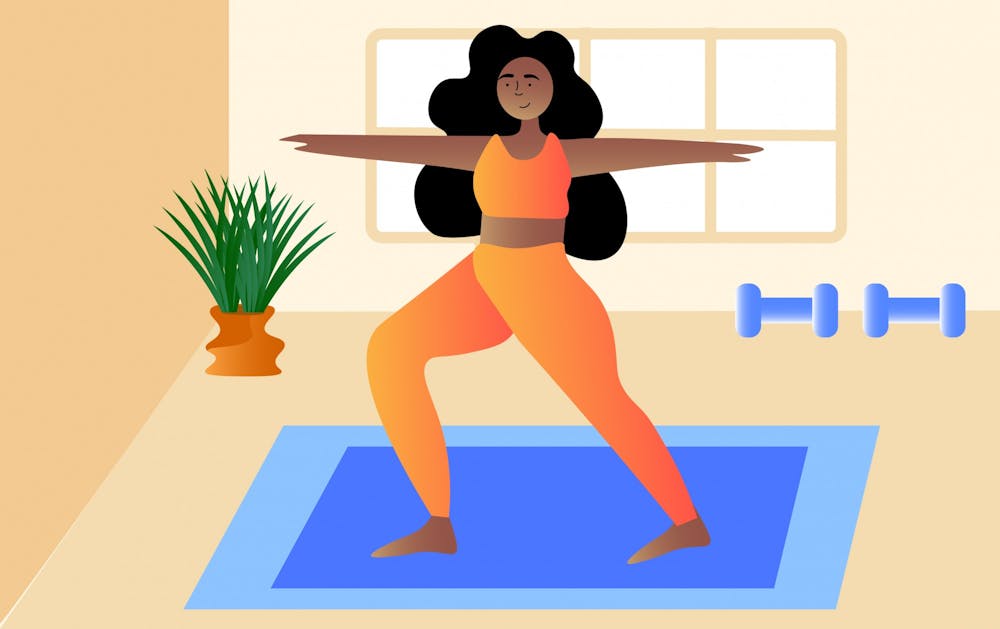With gyms closed and social distancing guidelines in place, maintaining a healthy lifestyle can be challenging — especially for students functioning on a new daily routine.
From at-home workouts to balanced meals, experts and students say there are various ways one can remain active while at home during the COVID-19 pandemic.
Regular physical activity is something people of any age can benefit from and "one of the most important things (one) can do for (their) health," according to the Centers for Disease Control and Prevention.
Stronger bones and muscles along with decreases in the risks of anxiety and depression are just a few of the immediate and long term positive effects that exercise can have.
Shannon Mulhearn, a graduate student and physical education course instructor, said online workouts are a great way to stay active at home.
“If (people) don’t have activities that they already enjoy that are solo or that only involve the people that are in their house, there’s a ton of online videos that are out there for free,” Mulhearn said. “There’s a lot of companies that are offering free trials ... because of COVID.”
For students to be physically healthy during these times, Mulhearn said they should work out for 30 minutes a day, five days a week.
Making healthy food choices and prioritizing nutrition is another difficulty some may be facing during the pandemic.
Christy Alexon, a clinical associate professor and registered dietitian, said vitamin C and vitamin D supplements are important for students who have limited access to fruits and vegetables or can’t go outside frequently. Alexon advised students to take them at a moderate amount.
Alexon recommends that students think “outside the regular pasta box” and turn to frozen fruits, healthy pasta alternatives and meats such as canned tuna.
“In terms of overall health, you want the foundation of your diet to be lean proteins and vegetables,” Alexon said when discussing how students should maintain a healthy diet during this time.
Getting outside has also been a popular activity, whether going for a run, walk or bike ride.
Mulhearn suggested that students make an effort to go outside and practice social distancing by jogging or biking while maintaining a 6-foot distance from other people.
“There is evidence that fresh air and sunlight are good for you and for your immune system," Mulhearn said. "I do believe that you can honor the social distancing recommendations and still stay physically active.”
Maintaining a distance farther than 6 feet and wearing a mask are additional precautions some experts advise for those exercising outdoors.
Misha Jones, a master’s student studying sports journalism, said that since social distancing regulations were set, her physical activity and healthy habits have increased. A daily workout and drinking water are some ways she’s prioritized her health.
“I also get up every morning and do a quick little ab circuit to wake myself up and get some endorphins flowing,” Jones said.
Jones added that social distancing has created more “idle time” for her to practice healthy habits.
Morgan Kurtz, a junior majoring in political science, shared a similar increase in physical activity. With this newly-found freedom on staying active, a fitness station set up in her living room and access to online workout routines, Kurtz said the switch to at-home workouts has been easy.
“There’s a lot of fitness apps and stuff out there that provide all the guidance you need,” Kurtz said.
With the increase in time students have to be active, Alexon believes that this time of social distancing can lead to healthy changes being made in students’ lives
“There can be some good, healthy habits and changes to come out of this experience,” Alexon said. “So, try to make the best of the situation we are all in together.”
Reach the reporter at mbestrad@asu.edu and follow @MeIissaE on Twitter.
Like The State Press on Facebook and follow @statepress on Twitter.




